I have already mentioned that the three major goals for the World2 Tour will likely fall short of their original intentions, and that, barring any radical changes on plans for next year, I will only achieve somewhat more than half of what I had hoped. Of course, this will be in large part due to the extraordinary circumstances of the current year, and most people around the World will certainly not meet their goals for the year either. It now seems that my newly-created short term goals will all suffer the same fate, though not necessarily for the same reasons. After the last few months, which were often more taxing than I would have preferred, what I desired was a destination that would be a little more relaxing, with exceptional natural scenery, a smaller population, and perhaps even things like nice beaches, something I have seen surprisingly infrequently on this Tour. I was pleased to identify such a destination, and was decidedly looking forward to a chance to slack off a little for a couple of weeks. However, unforeseen local complications meant that only half of what I had hoped for would come to pass.
The country in question was one few people are familiar with, São Tomé and Principe, consisting of two fairly small islands, with same names as the country, respectively, located in the Gulf of Guinea, just under three hundred kilometers west of the African mainland and immediately north of the Equator. It is said that the islands had been uninhabited before Portuguese mariners landed there around five hundred fifty years ago. Their arrival led to the establishment of a permanent settlement, originally based on tropical agriculture, but, as happened to so many places in the region, gradually transitioning into a major transit point during the early colonial Slave Trade. Most of the population of the islands are descendants of people from the mainland, mainly from Angola and the countries on the north shore of the Gulf of Guinea, most of whom were brought to the islands against their will. Upon independence, in 1975, many of the Portuguese inhabitants abandoned the former colony and many of the light industries they ran were left to decay, their ruins still visible around the islands. Today residents of the islands primarily speak Portuguese, with a handful of creole dialects also in use in various communities, corresponding to their residents’ original point of origin on the mainland. That cultural story was enough to entice me to make a visit, however there were also additional factors that helped settled the issue.
As part of a long-extinct Volcanic Hotspot chain of peaks, the islands possess more impressive geographic features than I have seen through most of the earlier months of the year combined. Being located on the Equator, and constantly hit by moisture-laden southerly winds, these are some of the wettest islands to be found anywhere, but that has also resulted in their lush forest cover, still in place over a reasonable fraction of their area and home to many interesting bird species. There is only one city, located on, and eponymous with, the island of São Tomé, but it is very small, by capital city standards, with only small villages widely scattered around the rest of the islands. Both of these factors mean that it could be possible to enjoy cycling through areas of impressive natural beauty without the adverse effects of excessive amounts of motorized traffic. Tourism has not traditionally been a major part of the economy in the country, which usually means that what facilities there are will generally be much more to my liking. Additionally, as small-to-medium-sized Islands, located at a particular distance from a continental landmass, they both possess a high level of floral and faunal endemism, which alone would be reason enough for me to want to visit.
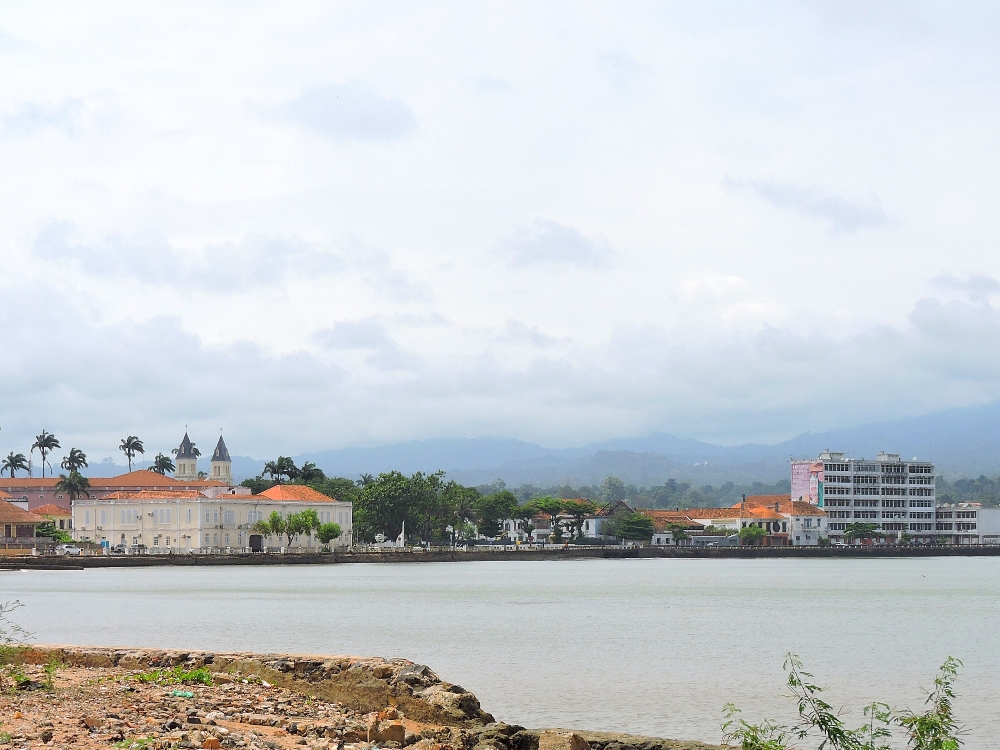
Of course, I would have preferred to reach the islands by sea, but, even before the current reduction in transport options, that would not be possible. Instead, I needed to fly from Freetown to São Tomé, changing airlines at Accra, Ghana, the location that caused an earlier frustration. There was a six-hour layover there, and, since I could not find a way to book both segments on the same ticket, that seemed like the right amount of time to claim my baggage and recheck-in for the second flight. Things did not go smoothly, which should have been a clue as to how the rest of this visit would turn out. While I was not able to apply for a tourist visa to Ghana earlier, transiting passengers normally can pass through the airport without one, as in most other cities around the World. All of the other passengers from my flight, after filling out a few short forms and showing a negative covid test taken before boarding the first flight, were allowed to proceed up to the departures terminal. However, I was informed that since my flights were on separate tickets, in order to retrieve my baggage I would need to take an additional rapid covid test, at a cost of one hundred fifty Dollars and get a transit-visa for another fifty, all for the privilege of walking thirty meters over to the baggage room and then up the elevator to where the other passengers were. Even the people working around the immigration desks could see how ridiculous that was, but, after a few hours of waiting, and numerous fruitless discussions, I was becoming impatient, and just paid both charges. Finally, without much time left over I was checked in and this time I noticed both of my bags being loaded onto the aircraft, so all seemed to be reasonably well.
Arriving at São Tomé started out simply, but later things turned in the opposite direction. Passengers lined up on the tarmac to have temperatures checked and show their covid test results. This time I had two negative tests, taken within days, in my possession, so I was doubly safe. In this instance, there was not another test given upon arrival, so that sped the process up somewhat. Later, a PCR test would be needed before departure, and, on the bright side, that one only cost twenty-five Dollars. However, while all of the other countries I had been to recently, had a Web-based registration system, in São Tomé, their system was much less organized. With only a few flights per week operating at the time, tests were scheduled at specific times for each flight and given at the nearby army base, however, the airline had recently changed their flight schedules, and all of the dates posted there were incorrect. Eventually, that was clarified, but not without some unnecessary effort. Most people can enter the country for fifteen days without a visa, so at least the immigration process was quick. Shortly after, I had my bags, thankfully, and met the shuttle the hotel I had booked had sent to meet me. Not long thereafter, however, the most significant problem became apparent.
After the affair in Accra I had only twenty Euros in my possession, and, as I usually do, I went towards the ATM at the airport before leaving. However, the driver mentioned that it wouldn’t work
and after my recent experiences in Sierra Leone I wasn’t surprised, and expected to get cash later, in the city. Soon after, I was dismayed to learn that, while there are plenty of machines around the country, none of them are connected to the international network, meaning no cash for me. Some countries, Brazil being a notable example, have only a portion of their ATMs connected, but in São Tomé and Principe: none…zero…nenhum. I assumed, then, that cards would be used exclusively for this visit. No, again. Some establishments have card readers, but, as before, none are networked. The only location where international cards are accepted is one hotel in the capital, from an expensive Portuguese chain. The only other option presented to me was to go to the central bank in the morning, where I could then withdraw cash against my Visa card. I have done that on earlier tours, but not for many years, nevertheless the next day I was there at the bank waiting in a long line to obtain some local currency. An even more outlandish surprise soon followed, when I was told that my card wouldn’t work because it has printed numbers, not the raised variety found on older cards. Apparently, the bank uses one of those old-timey mechanical devices to make a carbon-paper impression of the card, the type of system most readers here are probably too young to remember (personally, I don’t think I have even seen one of those for thirty years, or more.)
Now I was really in a tough spot. To make matters worse, my flight arrived on a Friday evening, so I had to sit around until Monday to be able to work out a solution. Normally, I would have done more thorough research before booking, and if I had, I would have learned that visitors are usually told to bring enough cash along to cover their entire stay (which would have been extra troublesome for me, coming from the just slightly less currency-challenged country of Sierra Leone.) However, on such short notice, it has been enough of a challenge to research all the different covid policies of various countries and, honestly, even without that I may not have looked at the cash situation in advance because, well, we are entering the third decade of the twenty-first century, after all. I have toured in cash-only countries before, Cuba and Myanmar come to mind, but that was around fifteen years ago and even those two have caved in to the global financialization juggernaut. It may be that now, along with North Korea, and perhaps Afghanistan, São Tomé and Principe is one of the least monetarily connected countries in the World.
I worked around this issue by booking three days of lodging and food, at the opposite end of the island, along with a birding guide, for the end of my visit, and paying for that, along with my arrival hotel in the city, with bank wire transfers. I have used that method many times before, but only for big-ticket items, because the fees are quite steep and they take a few days to process. Then, in order to get at least some cash, I stayed one night at the expensive Portuguese hotel, and reserved a few more nights before my departure. Since they take cards, they are willing to give cash advances, for a fee, but the catch is they can only do that if they actually have any cash on-hand, which is only a fraction of the time, so I wasn’t able to get as much as I wanted. The first casualty of this situation was that I no longer had enough time to go to Principe Island, which has its own set of endemic birds, so right from the start I only got to see half of the islands that I had desired.
Finally, I was anxious to put all of those annoyances behind me and to try to enjoy some of what I had come for. There are only three roads on São Tomé, so routing would not be not an issue. I took a short birding ride along the one that heads towards the west coast during one of my wasted early days, and was a little worried because it was severely potholed. Fortunately, the other two were in beautiful condition, at least for the first two-thirds of their distance, after that they each had some issues. More importantly, the traffic was as light as I had hoped, at a level I hadn’t experienced in months. Terrain, on the other hand, was a bit less advantageous. The central road begins to ascend right away, towards the highlands, and past the settlement of Monte Café, where coffee is obviously grown, it reaches an altitude of one thousand fifty meters. Surprisingly, that was the highest elevation I had reached by cycling since I was in the Dominican Republic during the first year of the Tour, and the high humidity made it feel totally draining.
The road down the east coast of the island was very beautiful, and also low-traffic, once away from the city, but, though there were no major climbs, the route was constantly rolling, which made it feel almost more tiring. Originally, I had hoped to take a day or two off along the way, but with time constraints, I was only able to stop early on the day I dropped down off the mountain. So I only had half as much relaxation as I was seeking.
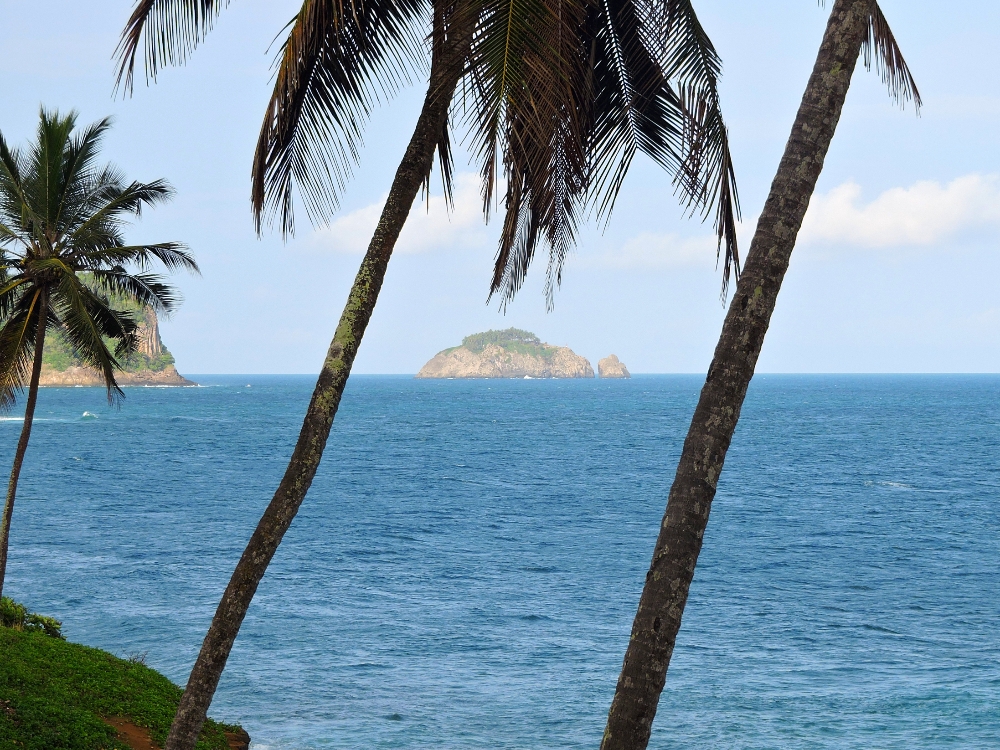
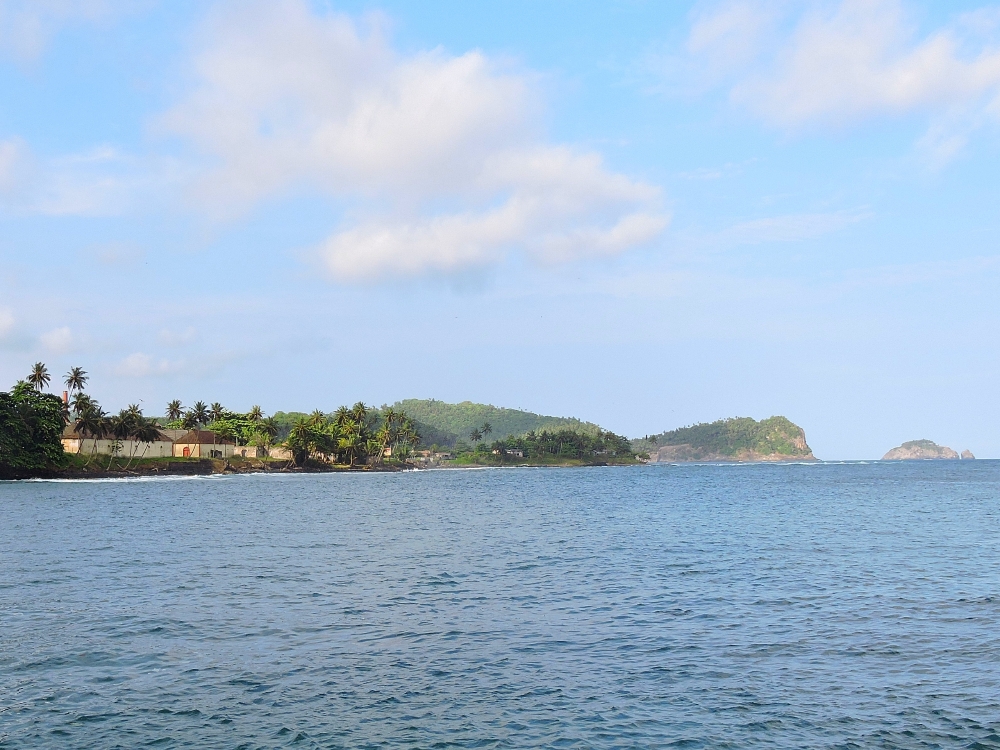
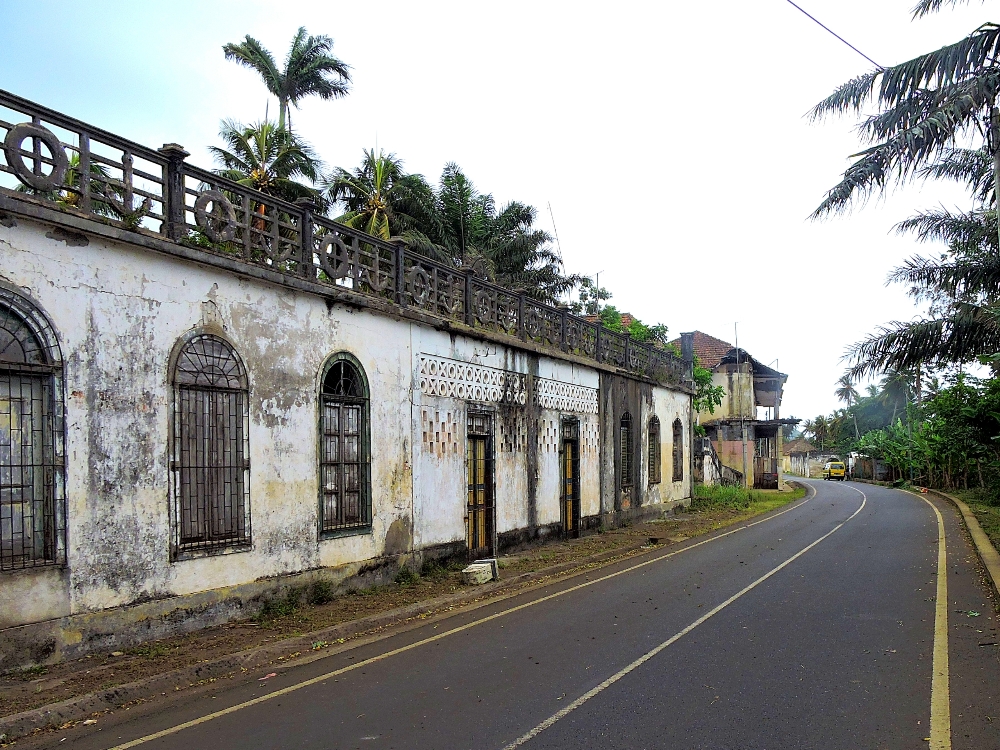
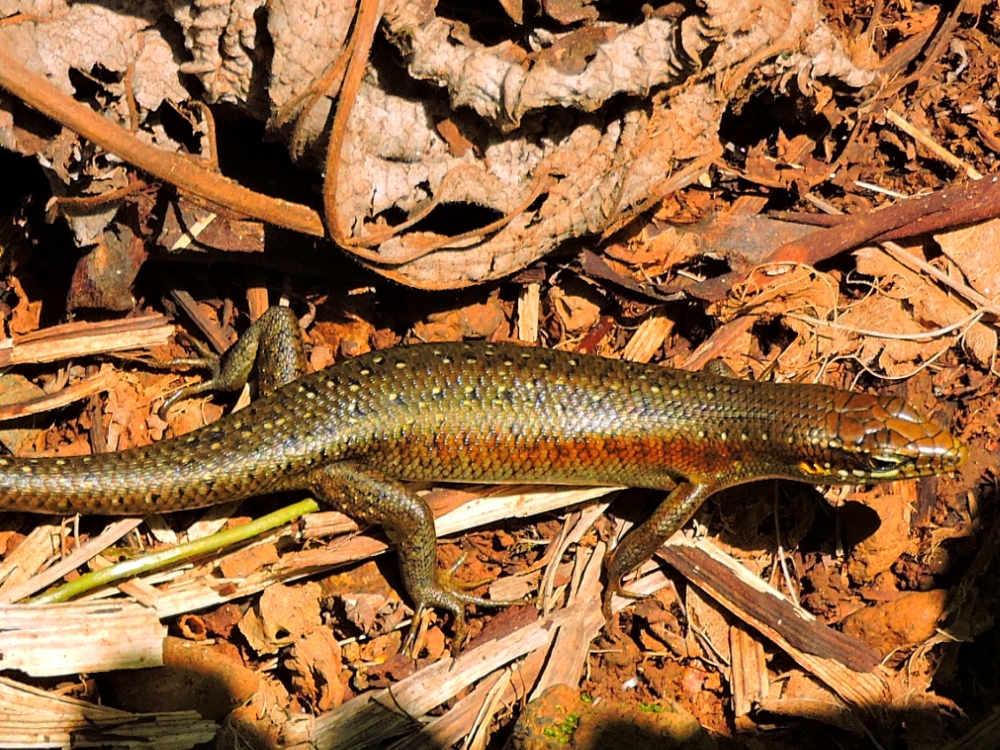
The southern edge of the island is probably its most beautiful region, and this is where the most impressive geological features can be seen, including the famous Pico Cão Grande, a free-standing volcanic plug. However, given the typically cloudy or misty climate, it is often only possible to see half of these beautiful vistas. The lodging I had paid for in advance was an eco-lodge, called Praia Inhame, and I was not quite sure what to expect. In fact, it was surprisingly pleasant, with nice bungalows, a good restaurant, and fast, stable Wi-Fi. The latter aspect was much appreciated and, in general, both the internet and municipal electricity were much more dependable in this country compared to the previous four I had passed through, which I found somewhat surprising for an island nation. At the lodge I had one day for birding in Obo National Park, and one reasonably quiet day, on which I went to a smaller island offshore, Ilhéu Rolas, Dove Island,
where the Equator crosses the land and where there is a nice monument to mark that occurrence. This was my second land-based encounter with the great line during the Tour, though without the bike this time, and the fourth overall during all my tours. This marker is my favorite 9f all of those thanks to the really cool mosaic map at its base, however, GPS does seem to indicate that the marker is a few meters away from the actual line. In the nearby village, a narrow dirt path, with a drain pipe running down its center is in a more accurate position. No one could say which way the water swirls as it flows down the pipe, however.
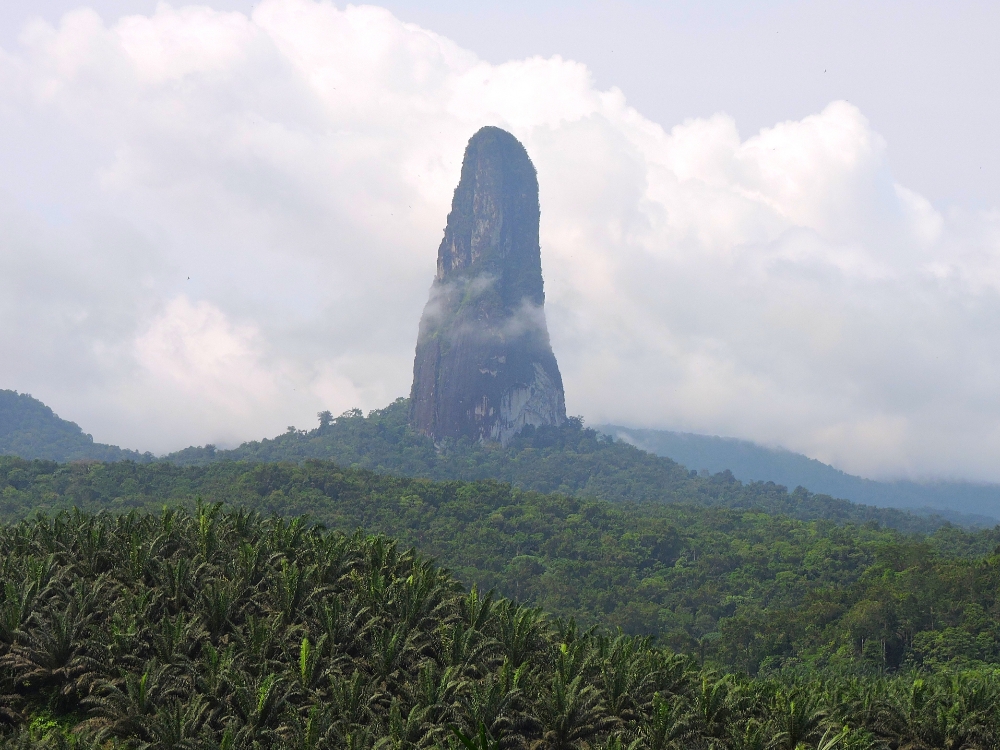
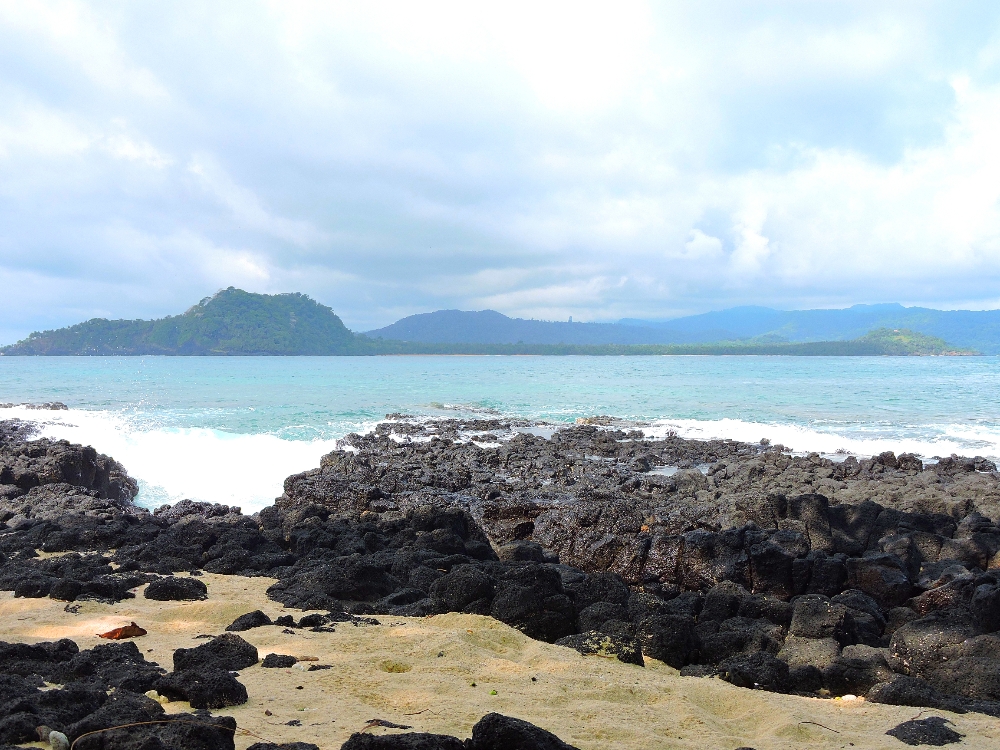
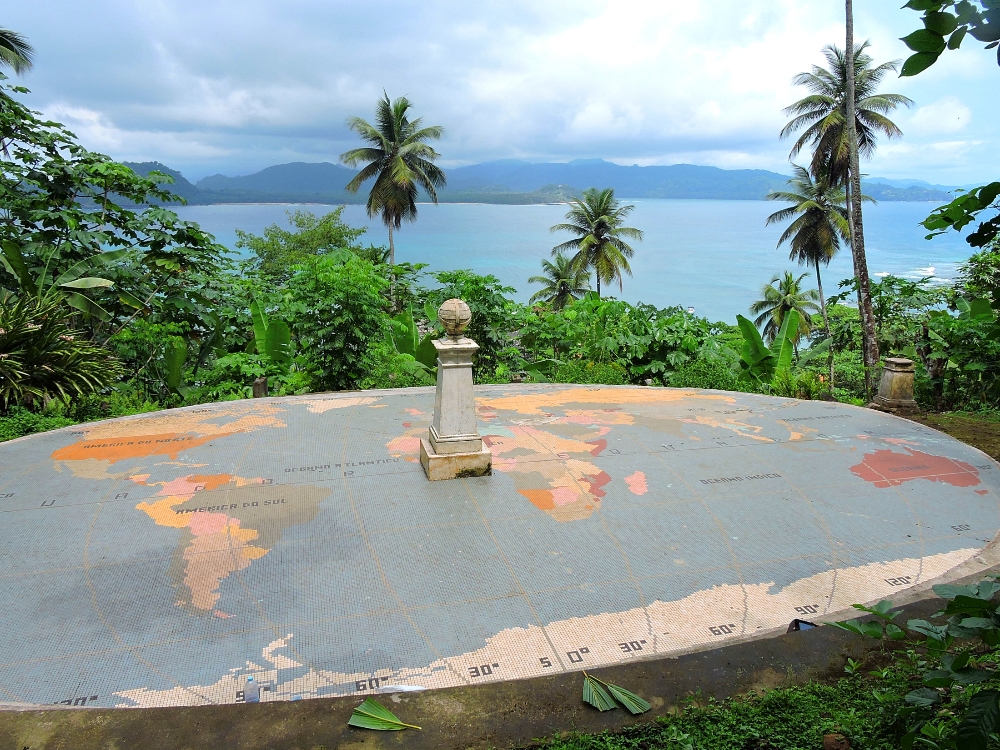
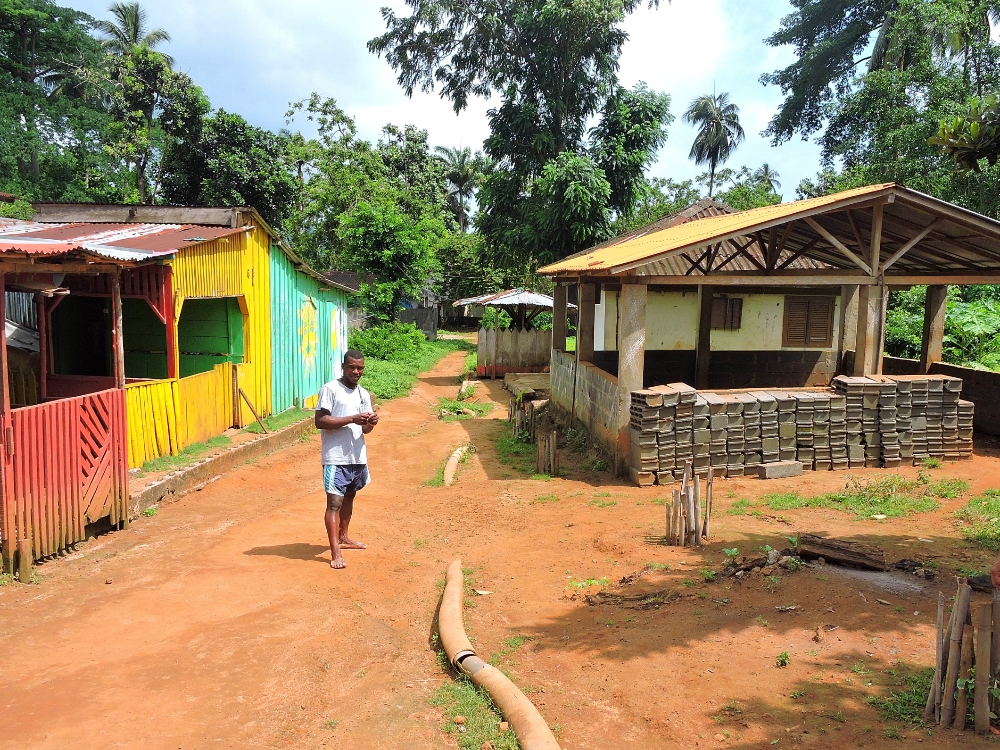
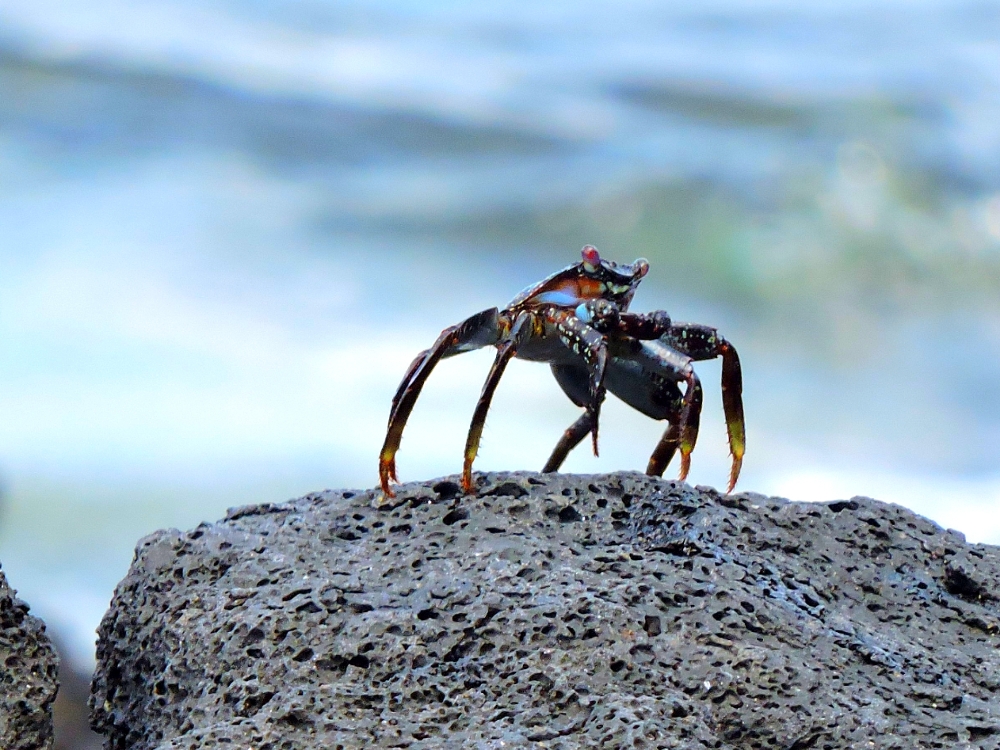
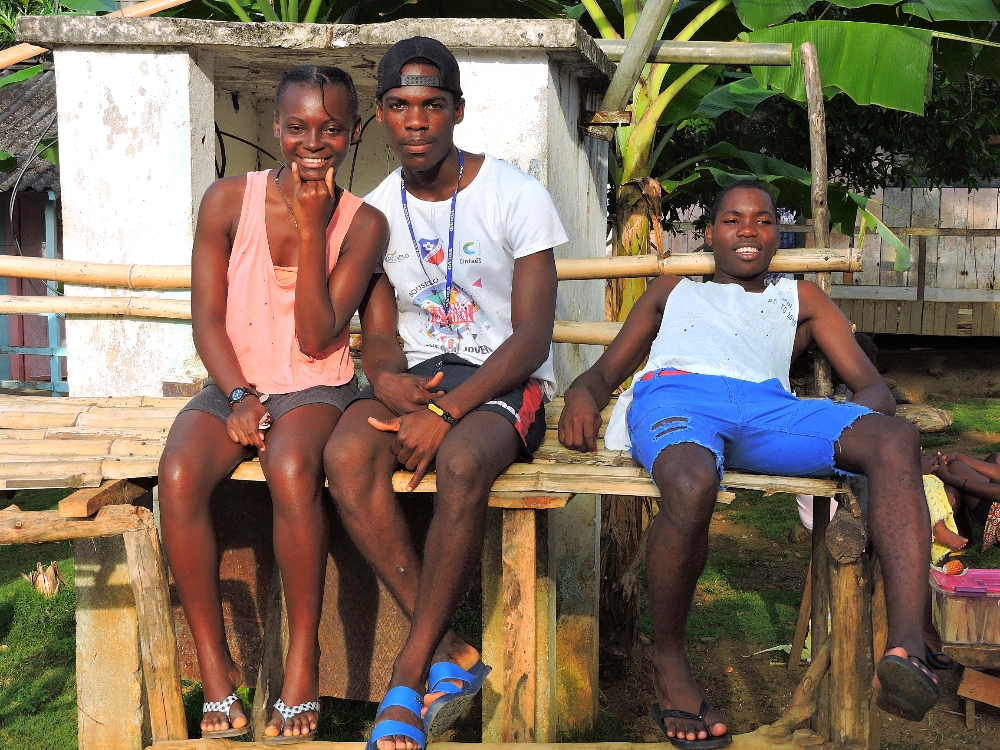
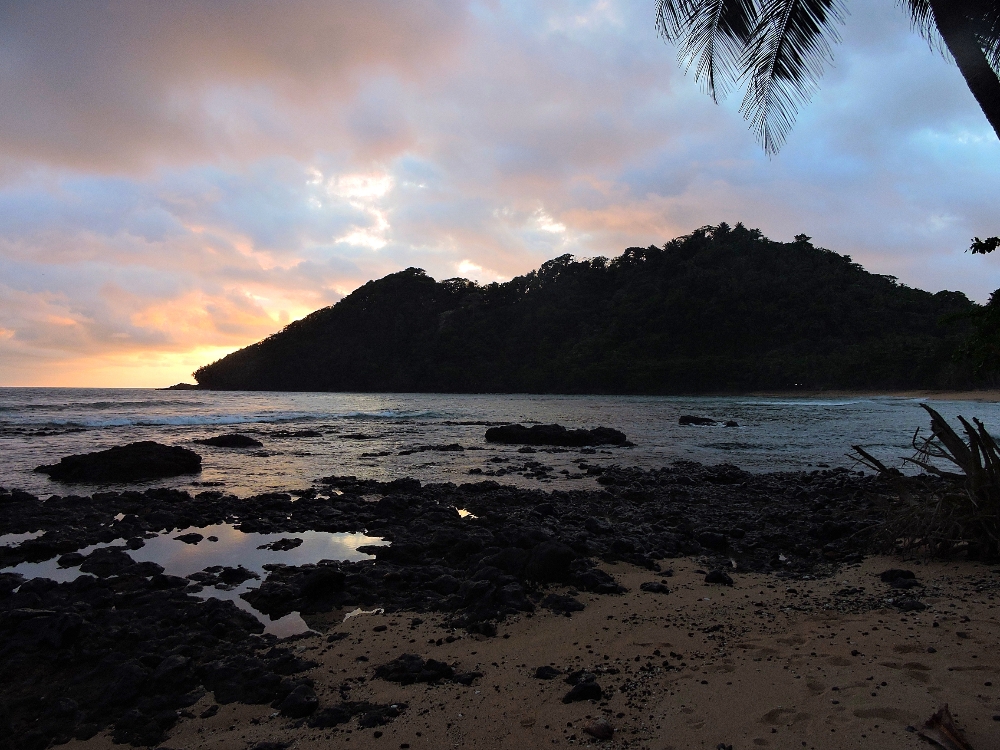
To return back to the city in time to take my departure covid test I had to ride the entire short, but strenuous, distance in a single day. That would not have been an issue except that, while I had paid for all of my food in advance at the lodge, drinks were extra, and I neglected to check the prices for the few cold fruit sodas I had while there. The cost was five times what I had paid along the road and that meant the I used up all my last bills, all my last coins, before I started the ride, and would have to forgo extra snacks or drinks along the way, depending instead on fast water emanating from the mountains. I survived, but I was halfway exhausted.
I don’t want to sound too disparaging about São Tomé. Were it not for the money problem, it might have been one of my favorite countries. The general travel conditions are good, the people are very friendly, the food is usually tasty, when you have cash to actually buy some, that is, and the island itself is magnificent. It is hard to look past all of the accumulated costs, however. Summing up the bank fees, the expensive hotels, cash advance fees, the health tests, including annoying one in Accra, the airfare, with an above average bike fee, courtesy of TAP Portugal, this country feels almost as costly as Greenland was last year, but not quite, and that is not really what one expects in Africa. It would have been great at half the cost, and I certainly could have used a place like that at the time.
My next destination is back on the mainland, not very far away, but, aggravatingly, because of covid there are currently no direct flights. I will need to connect through Accra again. Oh no.